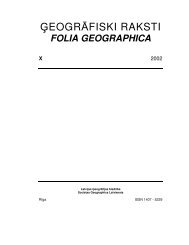eogrÄfiski raksti folia geographica xii - Ä¢eogrÄfijas un Zemes zinÄtņu ...
eogrÄfiski raksti folia geographica xii - Ä¢eogrÄfijas un Zemes zinÄtņu ...
eogrÄfiski raksti folia geographica xii - Ä¢eogrÄfijas un Zemes zinÄtņu ...
You also want an ePaper? Increase the reach of your titles
YUMPU automatically turns print PDFs into web optimized ePapers that Google loves.
DEVELOPMENT OF PLACES AND REGIONS<br />
Daugavpils, Rezekne and Jelgava also have several structures, which deal with<br />
marketing, but there is very little in the way of co-ordination of their various activities. Lacking<br />
is an agency that would be responsible for the entire process.<br />
The marketing strategy and documents which regulate it<br />
In this context a long-term marketing strategy is one of the most important criteria here,<br />
because it covers future visions and goals, as well as providing a long-term, concrete plan of<br />
action. A strategy helps the relevant institutions to systematise and plan their operations, to<br />
determine the necessary financial resources, and to decide on how the money is to be spent.<br />
Long-term activities are divided up into shorter periods of time (years or months). That makes it<br />
easier to monitor developments. If there is no long-term strategy, if there are no clearly defined<br />
goals, then the process of marketing activities lacks control over results, and decisions on new<br />
projects are taken in an arbitrary way.<br />
Ventspils is the only city, which has a long-term marketing strategy. It was drafted in the<br />
spring of 2003 and has been implemented since then. Riga, Jurmala, Liepaja and Jelgava are<br />
working on long-term marketing strategies or operating on the basis of short-term and<br />
temporary plans. In Daugavpils and Rezekne people are still thinking about working on a longterm<br />
marketing strategy.<br />
The logo, the slogan<br />
A logo and a slogan work together to shape a city’s brand, promoting its recognition<br />
among other cities. The brand emphasises the specifics of the city and makes it more<br />
competitive. Logos must be easy to perceive and each city should have no more than one.<br />
Slogans also describe cities. When a brand is being developed, it is easier to disseminate a<br />
single slogan, preferably one that is appropriate for as broad a target audience as possible.<br />
Ventspils is the only city that has a logo and slogan for advertising and promotion<br />
purposes. The logo includes three things: history (a castle, meaning endurance), the sea<br />
(dynamism and worldliness), and the word “Ventspils”, painted by brush. The colours are<br />
reminiscent of the s<strong>un</strong> and a city by the sea. “Ventspils – a City With a Tomorrow!” is the<br />
slogan.<br />
As mentioned above, Riga received a slogan and logo for its 800 th anniversary, but it is to<br />
be replaced with another graphic design in the future. Jurmala calls itself the “City on a Wave”<br />
and has a new logo and slogan. Rezekne and Jelgava have not developed any logo, while<br />
Daugavpils uses one that is not very well known. Liepaja has several slogans, but none is<br />
official. Daugavpils has two slogans, one of which has not been approved officially.<br />
The image of a city and its specifics<br />
The image of a city has much to do with stereotypes, which people hold about it. The<br />
image is solid if the dominant stereotypes are positive ones. If the image is less than solid then<br />
there are many different stereotypes and none is really dominant. If a negative stereotype<br />
dominates, then the image of the city must be repositioned.<br />
Riga, Ventspils, Liepaja, and Jurmala all enjoy a positive image. Riga is a highly varied<br />
city and its image needs to become more solidified. Riga is still using the logo that was<br />
developed for its 800 th anniversary, but the Riga City Co<strong>un</strong>cil wants to change it, thus a new one<br />
is <strong>un</strong>der development [Ruskuls 2003]. The slogans are “Riga: A City of Inspiration” and<br />
“Riga – the Hottest City in the North”. The stereotype of Riga as “little Paris” has been aro<strong>un</strong>d<br />
for a while.<br />
Daugavpils and Rezekne also have mostly positive images, but insufficiently concrete<br />
ones. Daugavpils began to think about its image as it prepared for its 725 th anniversary in 2000.<br />
The Daugavpils fortress was chosen as the symbol of the city, but it’s not used very often. The<br />
city’s official seal, which includes a depiction of the fortress, is used more frequently [Smagars<br />
2003]. The city has two slogans to popularise itself – “Daugavpils: A City on the Daugava” is<br />
not a very inspiring slogan, because Daugavpils, of course, is not the only city on the river. The<br />
Daugavpils Regional Tourism Information Centre is trying to bring in a new slogan: “Welcome<br />
to the Heart of Europe”. That’s not a very successful slogan either, because the centre of<br />
78

















